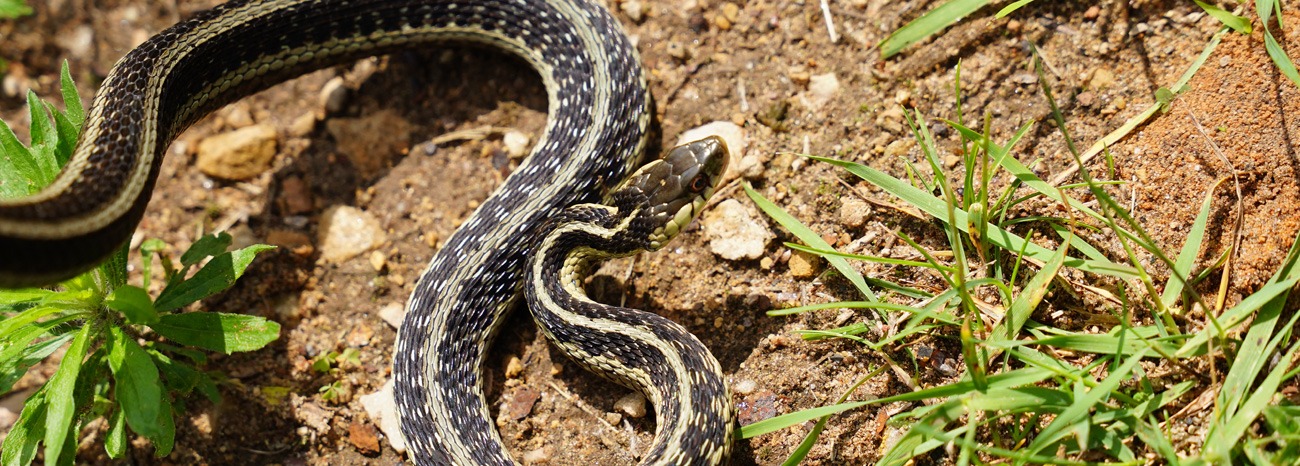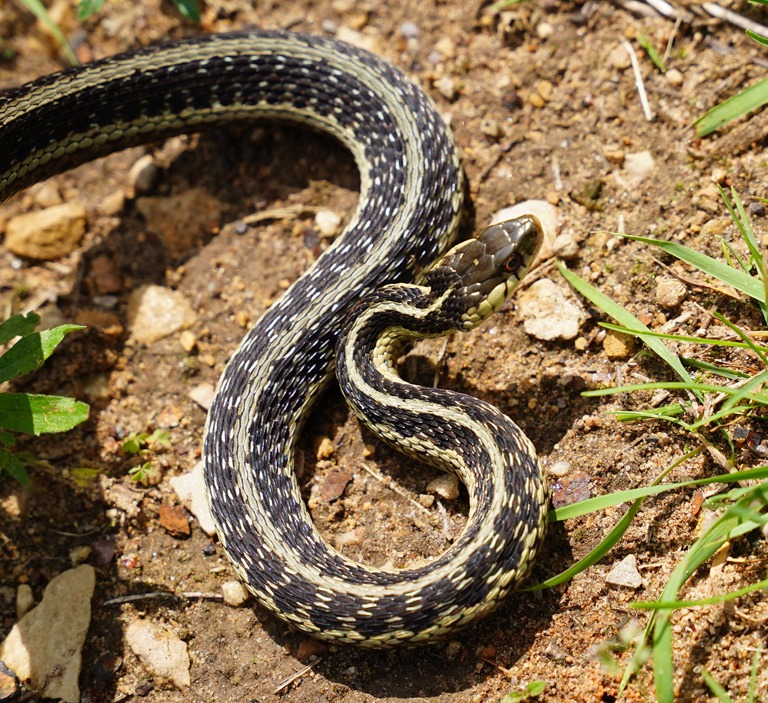If you’ve ever spotted something slithering through your garden or under your porch, you’re not alone. One of the most common backyard visitors in Pennsylvania gardens is the garter snake. While they’re usually harmless, that doesn’t mean you want them hanging around.
Let’s talk about why garter snakes show up in the first place, how to gently encourage them to move along, and when it makes sense to call in a professional. Although we do not treat or remove these beneficial creatures, we get many calls about them.
First Things First: Are Garter Snakes Dangerous?
Garter snakes might look a little intimidating, but they’re not dangerous to people or pets. In fact, they’re considered beneficial in many backyards because they help keep pests in check by eating slugs, insects, worms and even small rodents.
But just because they’re helpful doesn’t mean everyone wants them around. If you have pets that like to explore, kids who play in the yard or if snakes just aren’t your thing (totally understandable) it’s okay to want them gone.
How to Know If It’s a Garter Snake
Once you know what to look for, garter snakes are pretty recognizable. There are other species in the genus Thamnophis, like ribbon snakes, that look similar but are also harmless. Garter snakes range between 18 and 26 inches long, but they can grow larger. They have a base color ranging from dark green to brown to black and are recognized by three light-colored (yellow or white) stripes running down their backs.
They’re active during the day and tend to flee quickly when approached. If they feel threatened, they might flatten their bodies or release a musky odor (which is not pleasant but also not harmful). And while garter snakes don’t lay eggs (they give birth to live young) you might start seeing more of them in late summer if they’ve been nesting nearby.
Why Are Garter Snakes in My Yard?
Your lawn may be beautiful but snakes don’t just show up for fun. They’re looking for food and shelter. If your yard offers both, you’ve basically rolled out the welcome mat.
Conditions that attract garter snakes:
- Tall grass or dense ground cover where they can hide
- Rock piles, brush, firewood stacks, or other debris that provide shelter
- Water sources like ponds, birdbaths or even leaky hoses
- Food sources like insects, earthworms, frogs or small rodents
Sometimes, just a few overgrown spots or a damp corner under the deck will be enough to lead a garter snake to call your backyard home.
How to Get Rid of Garter Snakes, Humanely
If you’re not interested in becoming a landlord to a garter snake, here are some successful ways to encourage them to move along without hurting them or disrupting your yard’s ecosystem.
1. Clean Up Their Preferred Hiding Spots
Start with some basic yard clean-up:
- Mow your lawn regularly
- Trim shrubs and groundcover
- Clear out leaf piles, woodpiles and overgrown corners
- Keep firewood stored off the ground
Snakes love places where they can stay cool, hidden, and undisturbed. The less cozy your yard is, the less likely they are to stick around.
2. Seal Off the House
While garter snakes usually stay in your yard, they can find their way indoors through small openings. Prevent this from happening by:
- Checking your home’s foundation for cracks
- Looking for gaps under doors, around pipes and in vents
- Using hardware cloth or weatherproof sealant to close things up
Taking these steps around your home’s perimeter will help them stay outside.
3. Try Natural Repellents and Barriers
Sometimes, natural methods like a scent-based snake repellent will do the trick. Look for products that use ingredients like cinnamon oil, clove oil or sulfur. Many of these products are safe for use around pets and children, but always read the label to be certain.
You can also establish a barrier by making your landscaping less snake-friendly:
- Add a gravel border around your house or garden (snakes don’t like rough textures)
- Avoid mulch-heavy areas close to your home
- Keep compost contained
4. Consider Live Trapping (If It’s Legal in Your Area)
If you have a visit from a particularly persistent snake or you’re pretty sure there’s a nest nearby, live trapping may be an option.
A few tips:
- Only use traps designed for snakes and definitely only where it’s legal to do so.
- Set traps near where you’ve seen the snake moving.
- Check the traps daily.
- Once caught, relocate the snake far from your residential neighborhood, ideally in woods or open fields.
Next Steps
Although we do not remove or treat for garter snakes, we are trusted by thousands of households to address a wide range of common household pests. Click here to view our Home Guard Plans, or give us a call at 215.799.2010.
FAQs
Do garter snakes hibernate in residential areas?
Yes, they often find winter shelter under porches, in crawlspace, or in basements.
What should I do if my pet catches a garter snake?
Stay calm. Garter snakes aren’t venomous. If you think your pet encountered a garter snake, check for any signs of bites or injury and contact your vet.
Are store-bought snake repellents safe for children and pets?
Many are, but always check the label. Natural formulas are generally safer for use around children and pets.
How can I tell if a garter snake is nesting on my property?
If you see multiple snakes, shed skins or baby snakes late in the summer, you may have a nest.
Will removing garter snakes cause an increase in other pests?
It’s possible since garter snakes help control bugs and rodents. The key is to address both the snakes and what’s attracting them.
For more about the pests you may encounter around your home, visit our Pest Library.

